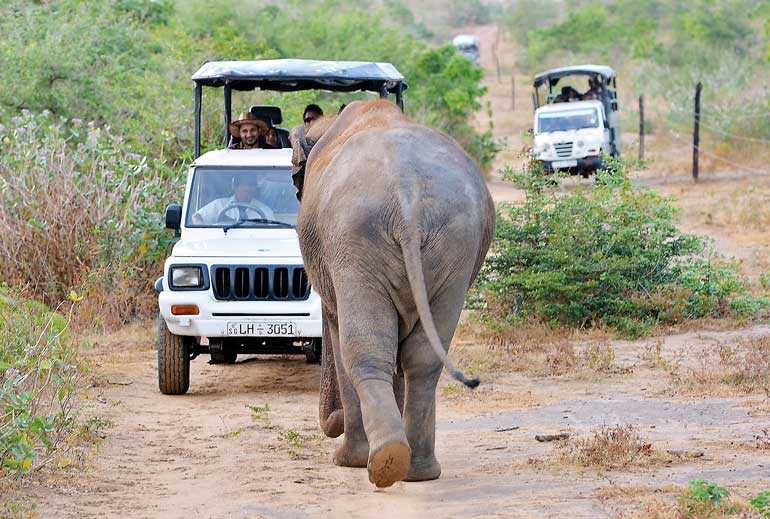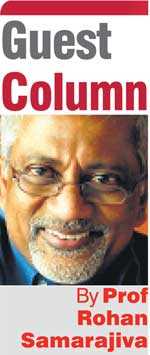Tuesday Dec 30, 2025
Tuesday Dec 30, 2025
Thursday, 2 January 2020 00:37 - - {{hitsCtrl.values.hits}}

Changing the behaviours of large masses of people and of organisations is no easy task and requires careful preparation, continuous monitoring and evaluation and a readiness to tweak the modalities and amounts based on feedback. But short of using technological and economic means to alleviate the negative externalities of current ways by which individuals use scarce resources, we will not be able to arrest the degradation of the user experience – Pic by Shehan Gunasekara
Overtourism is a thing. It affects the Mona Lisa painting at the Louvre; it happens on weekends in Sigiriya; it has caused some to stop going to traffic-jam-ridden Yala. Too many people wanting to look at the same thing at the same time make the experience unpleasant for all.
One solution is to dissuade people from crowding the locations by distracting them with simulations such as sound and light shows. Virtual-reality and augmented-reality technologies offer additional opportunities in this regard. But people want the real thing. As one who has beheld Da Vinci’s masterpiece and climbed the spiral staircase to the Sigiriya frescos, who am I to deny others their wishes?
Congestion pricing
William Vickrey, who was awarded the Nobel Prize for economics in 1996 for other work, proposed a general solution for the problem of congestion back in 1952. His idea took a long time to be accepted, partly because of the conservatism of government decision makers and partly because the required technology was not quite ready. But now the technology exists to implement congestion pricing; what is lacking in many countries is economic literacy.
The basic idea is simple. Charge high prices at times of peak demand and have it taper off to nothing at times of low or no demand. This will incentivise those who are able to change the time or mode of consumption to do so, reducing congestion at peak. Demand at peaks will be lowered and demand in the valleys will be increased, allowing for more efficient use of the available resource and reduction of the costs imposed on users by congestion. This has been implemented in Singapore and London for high-demand roads with great success.
Congestion pricing promotes use of vehicles by multiple passengers, thus reducing the number of vehicles on the road. Most importantly, congestion pricing shifts passengers away from private vehicles to public transport and walking which are much more efficient. Singapore and London have good public transport systems. Congestion charge revenues are invested in improving public transport. In cities that lack good alternatives to private vehicle transport, it is imperative that improvement of public transport is tightly articulated with the introduction of congestion pricing and that all revenues from congestion pricing be spent on public transport.
Singapore gives primacy to changing the behaviours of passengers and not to the raising of revenues. Therefore, the prices that are charged are communicated to the driver in real time. Variable pricing that would be adjusted up or down in real time, depending on traffic volumes, is also being explored. 
Application to tourist attractions
The road pricing solution cannot be applied as is to tourist sites. All that can be done with attractions is to shift time of use; there is no equivalent of public transport. There are limits, even to time of use. Having tourists rolling through a wildlife park 24x7 is harmful to the animals. Many tourists are on tightly-scheduled itineraries and do not have the flexibility to change times of visit.
Congestion pricing can still be applied to evenly distribute demand during open hours. Actual limits or quotas will have to be imposed as well. However, it is not fair to a tourist, foreign or domestic, to be told after a long journey that no entry is allowed or that prices have been increased. Therefore, it is important to shift ticket purchases away from spot and onsite to advance and online.
At the moment a tourist, domestic or foreign, purchases a ticket she should be assured of entry and a reasonable opportunity to enjoy the attraction. If the bearing capacity of a particular time slot has been reached, purchasers should be directed to other time slots or even to other attractions. For example, a tourist may be informed that the permitted number of tickets for Yala have been sold for a particular day, but that tickets are available for nearby parks such as Lunugamvehera, Bundala or even Uda Walawe. This will allow demand to be more evenly distributed over time and space.
An elephant is an elephant, irrespective of the park it is in. But certain attractions are unique. There is only one Sigiriya and only one set of frescos within Sigiriya. Pidurangala can be developed as an alternative using the revenues from the tickets, but the frescos pose a harder challenge given the damage caused by time and treasure hunters.
The frescos could be priced as a separate premium product, allowing more people to enjoy the rest of the rock at a lower price. Here one would have to be creative in the use of virtual reality options that would be offered free or at low charges to those shut out from the fresco gallery.
Domestic tourists
Sri Lankans are proud of what their forebears built and of the natural treasures of the country. The most recent Household Income and Expenditure Survey showed that an average Sri Lankan household spent Rs. 414 on pilgrimages and excursions in 2016. In 2009-10 this expenditure was only Rs. 226. As household incomes increase, spending on domestic tourism is increasing faster.
The Government charges for admission from domestic tourists, which is a good thing. But in many cases the amount charged does not even cover the administrative costs of printing the tickets, maintaining the staff associated with the sale and inspection of tickets, etc. Admission prices must be revised at least to levels that cover these costs. The exorbitant prices charged foreign tourists is the cash cow than funds the relevant Government organisations, cross-subsidises domestic tourists, and also contributes to Treasury.
If Vickrey (time-based differential) pricing is applied to foreign tourists, they must be applied to domestic tourists as well. Otherwise the main purpose of managing congestion at peak times to enhance the tourist experience will be frustrated. The space created by foreign tourists who shift their consumption away from peak times will be filled by domestic tourists, defeating the purpose of improving the tourist experience.
If quotas are to be applied to the numbers of tourists permitted to enter during specific time slots, it would be necessary also to implement sub-quotas for domestic and foreign tourists. It may be easier to compel foreign tourists to purchase advance tickets online than to change the behaviour of domestic tourists, especially those who come in groups for whom purchasing advance tickets and arriving at a specific time may be too difficult in the short term.
A transitional remedy would be a green- and red-channel solution, wherein a gradually decreasing quota would be set apart for those buying differentially priced spot tickets on site. The green channel should be visible to those standing in the slow red channel along with information on how to avail of green-channel facilities. In the same way that those who check in for flights at the counter are motivated to switch to online check-in by the shorter lines, it is possible to drive behavioural change by use of parallel systems.
The need to study
The issues discussed above (and more) have to be addressed for the successful implementation of Vickrey pricing in tourist sites. This would require careful study, not only of the particular behaviours in specific locations that are sought to be modified but also of lessons from international experience.
Vickrey proposed the idea in 1952; the first report on its application in London was published in 1964; Singapore implemented a manual system in 1975 which was upgraded to the current electronic system in 1998; it took until 2003 for congestion charges to be implemented in London. The timeline illustrates the need for careful study. But the technology that is now available is miles ahead of what was available to the early adopters. And late adopters can learn from prior experience.
Changing the behaviours of large masses of people and of organisations is no easy task and requires careful preparation, continuous monitoring and evaluation and a readiness to tweak the modalities and amounts based on feedback. But short of using technological and economic means to alleviate the negative externalities of current ways by which individuals use scarce resources, we will not be able to arrest the degradation of the user experience. The choice is between Vickrey pricing for advance online tickets and unpleasant experiences at attractions that are supposed to bring us joy.